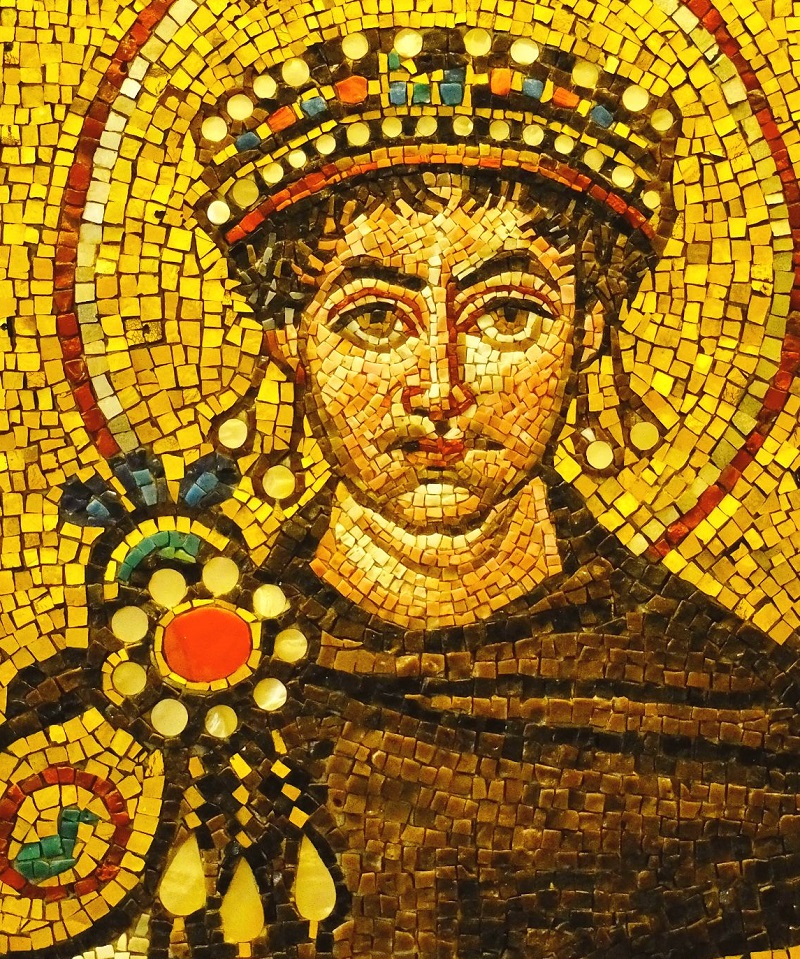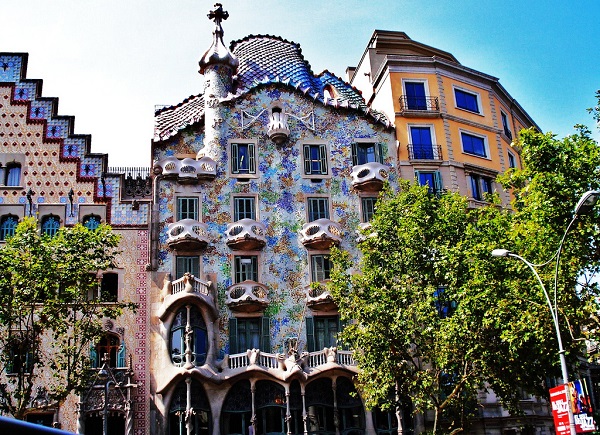Mosaic

|
| Fifth-century AD Roman mosaic in the Rotunda (Ayios Georgios), Thessaloniki, Greece. Photo: George Demetri |
Contents |
[edit] Introduction
A mosaic is an artistic composition made up of small, squarish, coloured elements (tesserae) which can be stone, glass, ceramic or other materials. Due to the durability of the materials generally used, mosaics can be placed outdoors as well as indoors, used on both walls and floors, and some have survived for millennia even when buried beneath the ground.
Making mosaics is an ancient art that has been practised throughout history. Today, contemporary mosaics are seen in public places, on the outside of buildings, in bathrooms, playgrounds and parks.
[edit] Historical development
The word ‘mosaic’ is thought to derive from ‘Moses’, specifically when he descended from the mountain with the 10 commandments inscribed on tablets of stone which he then shattered into many pieces.
Although mostly associated with Roman floors, the use of mosaics extends as far back as the Sumerians of ancient Mesopotamia (now Iraq) in the third millennium BC. These early examples comprised arrangements of coloured clay pegs pressed into wall surfaces. Mosaics were also developed by the Aztecs and Mayas of Central America.
The ancient Egyptians used small fragments of semi-precious stones and other materials to decorate walls and inlay furniture. However, the forbears of what are today considered as mosaics were the coloured stones and pebbles used by the ancient Greeks to create permanent designs.
That art was further developed by the Romans who used natural stones cut into more regular cubes. The Romans depicted a wide variety of subject matter and style in their mosaics, ranging from geometric arrangements and ancient gods, to everyday objects and the natural world. Many examples of Roman wall and floor mosaics – still in very good condition – are to be found in countries that once formed part of the Roman Empire.
Mosaics also formed an important aspect of Byzantine art and from the fourth century AD were used chiefly for religious purposes to depict Christ, the Virgin Mary and other saints. Byzantine mosaics tended to be highly luminous and characterised by the extensive use of gold-coloured tesserae with gold and silver leaf sandwiched between the layers of glass. The Byzantines innovated with a new type of tessera made of glass and called ‘smalti’ which would dominate Byzantine mosaics and gave artists a new range of luminous colours. Setting the pieces at varying angles into the mortar bed enhanced the reflectivity of the glass. Mosaics also formed an important component of Islamic art which focused almost exclusively on geometric designs.
In the following centuries, mosaics were to a large extent superseded by fresco painting but when used were often copies of paintings – a practice which continued into the 20h century.
The Art Nouveau movement created a revival of interest in mosaic making as an artistic medium and focused on pattern and simplified, stylised forms. Modernism further boosted the art, particularly the works of the late 19th century Catalan architect Antonio Gaudi who covered large expanses of external walls and park sculptures with his take on the mosaic. These comprised large, irregular, brightly-coloured ceramic pieces.
[edit] Making a mosaic
[edit] Materials
There is a wide variety of material from which to make the tesserae, including:
- Marble, smalti (opaque glass) and gold leaf.
- Glass and ceramic tiles.
- China, coloured glass and mirror.
- Pebbles, shells, beads and jewels.
- Salvaged materials.
[edit] Fixing the mosaic
Although mosaic tesserae were traditionally embedded into cement, today there are numerous backing possibilities, including wood, plaster, ceramics, terracotta and fibreglass. One of the most common methods is to place the tesserae onto a very thin bed of tile adhesive: this can be cement based, white PVA glue or epoxy resin glue, using just enough to ensure that when pressed into the cement it does not rise into the joints.
Grout (available in different colours) is used to fill the gaps between the tesserae – this strengthens the mosaic and can make it waterproof. The grout should have different qualities to the adhesive. Any excess grout should be wiped off immediately with a damp cloth.
For more detailed information on materials and techniques used to create mosaics, readers should consult specialist material suppliers.
NB Short Guide, Scottish traditional shopfronts, published, on 18 April 2017 by Historic Environment Scotland, suggests mosaics are: ‘Decorative ceramic made up of small tiles (tesserae) laid in mortar to form a decorative pattern. Patent or simulated mosaics were created to reduce the high costs of laying mosaic but still achieved a similar appearance. Fashionable in Edwardian period for the lobby floor.’
[edit] Related articles on Designing Buildings
- Aesthetic movement.
- Art Deco.
- Art Moderne.
- Art Nouveau.
- Arts and craft movement.
- Bauhaus.
- Beaux Arts style.
- Coal holes, pavement lights, kerbs and utilities and wood-block paving.
- Conservation, climbing and graffiti.
- Cosmati work.
- Floorscape in art and design.
- Fresco.
- Julian Opie Art Wall CitizenM Tower of London Hotel
- Mural.
- Nuclear Dawn mural, Brixton.
- Placemaking.
- Scagliola.
- Trompe l’oeil.
- Veneer.
Featured articles and news
Government consultations for the summer of 2025
A year of Labour, past and present consultations on the environment, the built environment, training and tax.
CMA competitiveness probe of major housing developers
100 million affordable housing contributions committed with further consultation published.
Homes England supports Greencore Homes
42 new build affordable sustainable homes in Oxfordshire.
Zero carbon social housing: unlocking brownfield potential
Seven ZEDpod strategies for brownfield housing success.
CIOB report; a blueprint for SDGs and the built environment
Pairing the Sustainable Development Goals with projects.
Types, tests, standards and fires relating to external cladding
Brief descriptions with an extensive list of fires for review.
Latest Build UK Building Safety Regime explainer published
Key elements in one short, now updated document.
UKGBC launch the UK Climate Resilience Roadmap
First guidance of its kind on direct climate impacts for the built environment and how it can adapt.
CLC Health, Safety and Wellbeing Strategy 2025
Launched by the Minister for Industry to look at fatalities on site, improving mental health and other issues.
One of the most impressive Victorian architects. Book review.
Common Assessment Standard now with building safety
New CAS update now includes mandatory building safety questions.
RTPI leader to become new CIOB Chief Executive Officer
Dr Victoria Hills MRTPI, FICE to take over after Caroline Gumble’s departure.
Social and affordable housing, a long term plan for delivery
The “Delivering a Decade of Renewal for Social and Affordable Housing” strategy sets out future path.
A change to adoptive architecture
Effects of global weather warming on architectural detailing, material choice and human interaction.
The proposed publicly owned and backed subsidiary of Homes England, to facilitate new homes.
How big is the problem and what can we do to mitigate the effects?
Overheating guidance and tools for building designers
A number of cool guides to help with the heat.
The UK's Modern Industrial Strategy: A 10 year plan
Previous consultation criticism, current key elements and general support with some persisting reservations.
Building Safety Regulator reforms
New roles, new staff and a new fast track service pave the way for a single construction regulator.

























